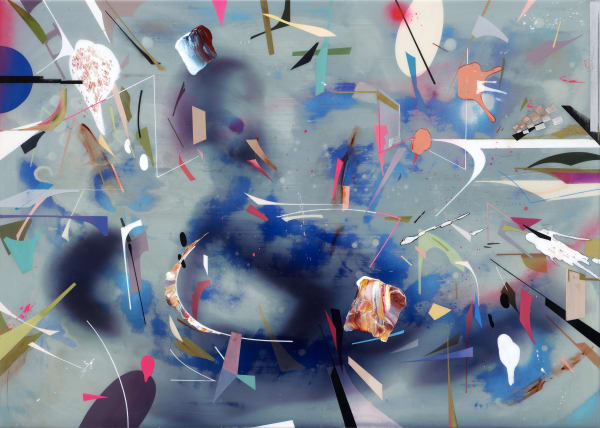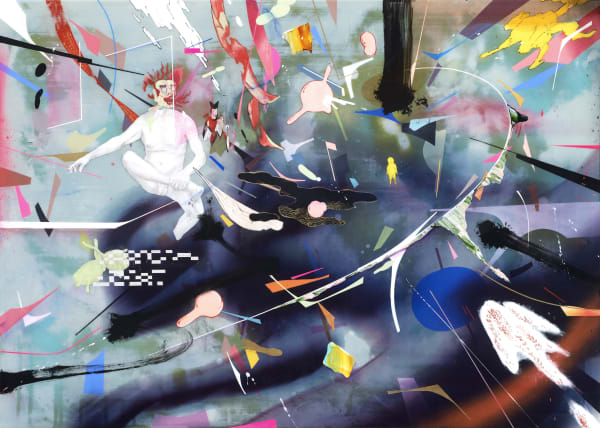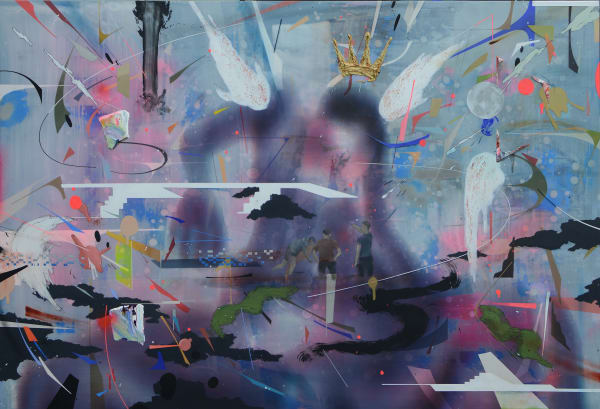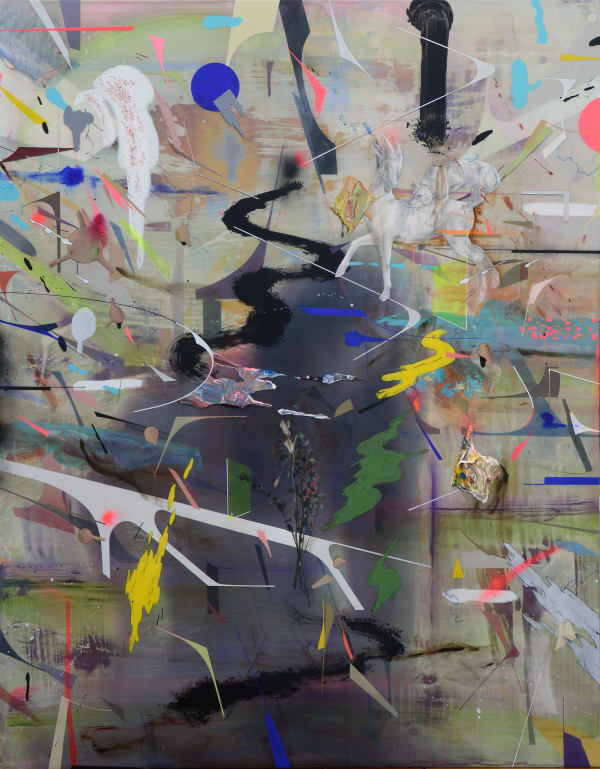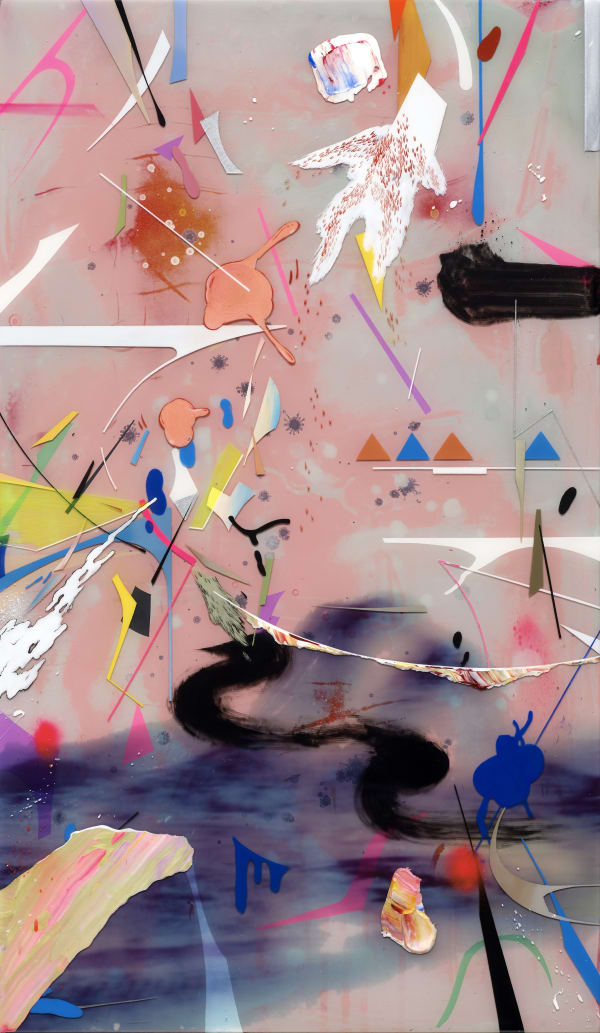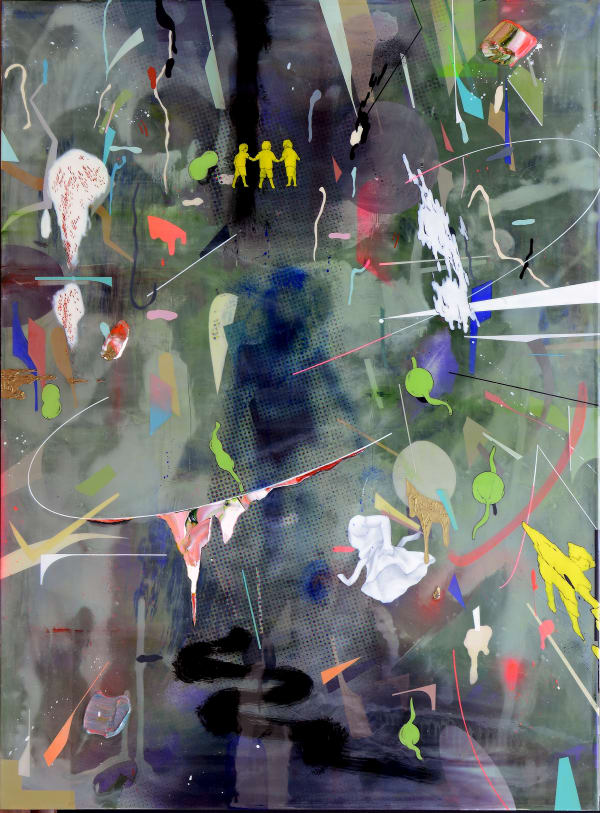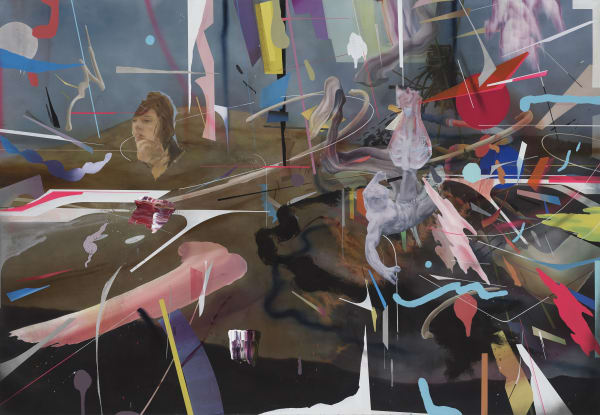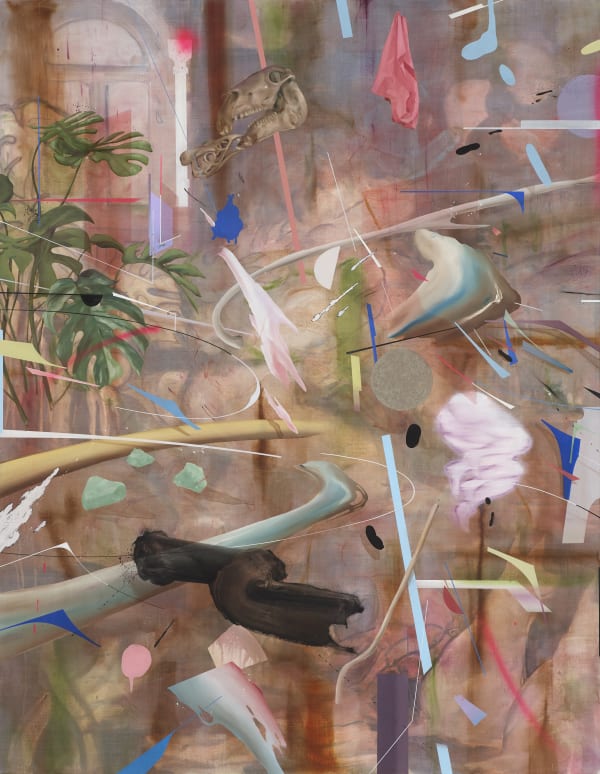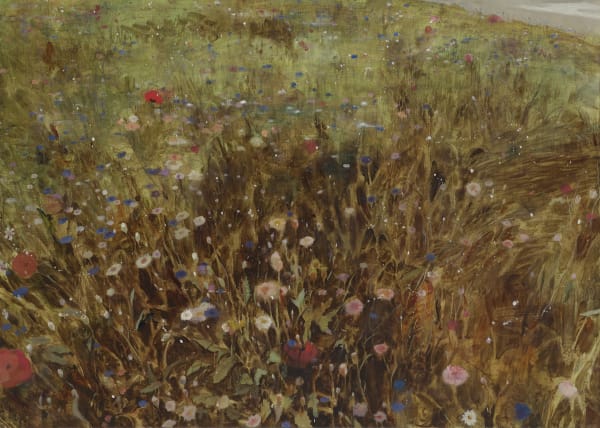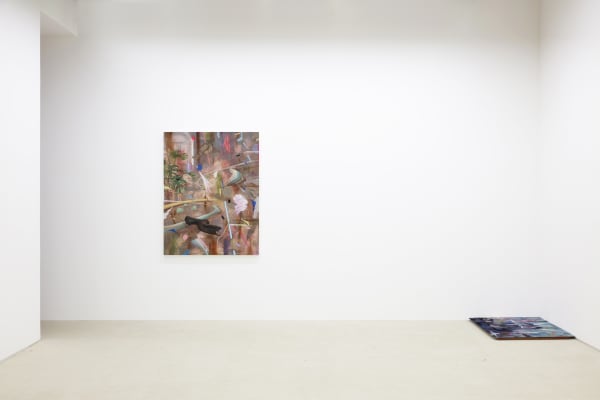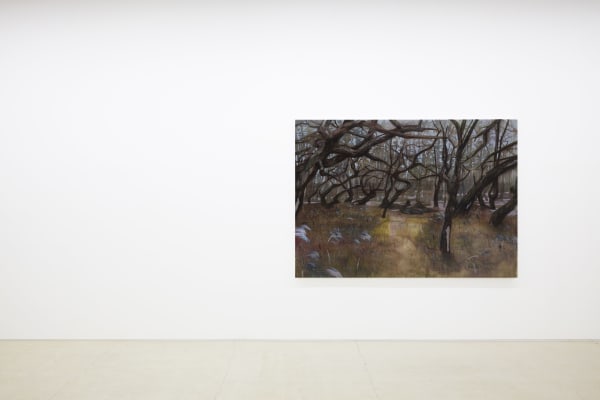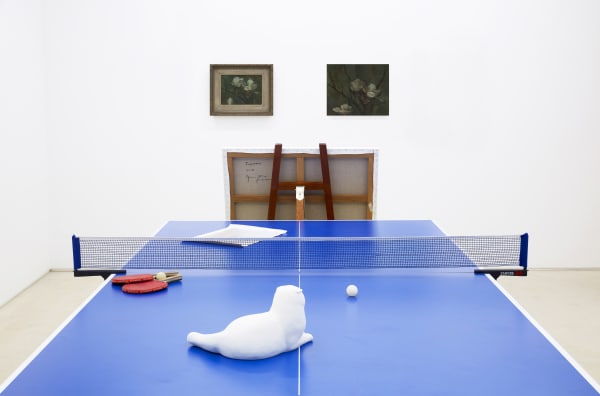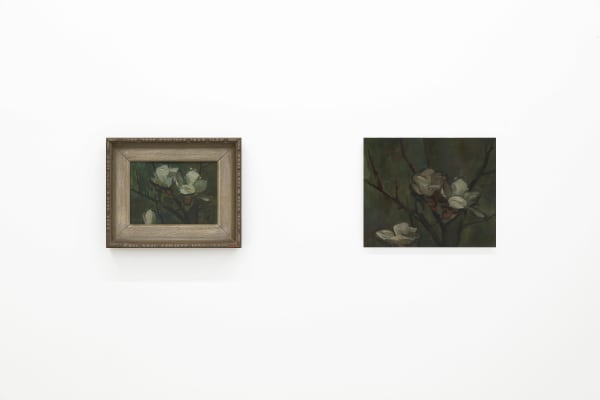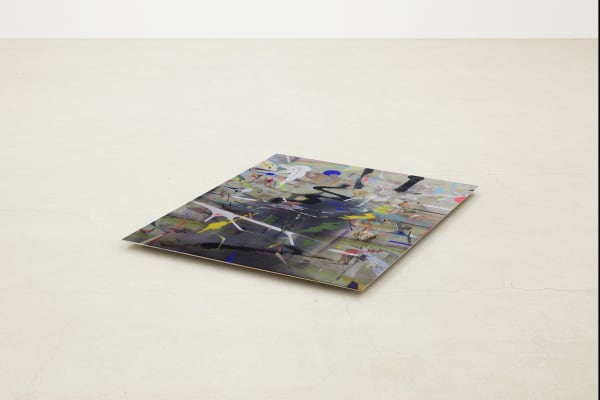SURFACE: 신건우 Gunsoo Shin
신건우의 작업은 ‘연극적 상황을 표현한 조각 행위’로 점철된다. 부조에 등장하는 인물은 마치 무대 위의 배우처럼 화면의 중심에 위치한다. 과감하게 생략되거나 혹은 초현실적인 분위기를 자아내는 배경은 설정된 상황에 놓인 인물을 더욱 부각시킨다. 그의 작업 중 부조가 배우를 위한 작품이었다면, 환조는 배우만 존재하는 작품이었다.
전시 제목인 ‘Surface’는 표면 혹은 외관을 의미한다. 표면은 입체적인 형상을 다루는 조각의 성격과 다소 상충한다. 평평한 외관을 주로 지시하는 이 단어가 암시하듯이 신건우의 이 번 개인전은 평면 작업이 주를 이룬다. 그는 예전부터 그림을 그리고 싶었다고 한다. 조각 작업을 위한 드로잉이나 제작 계획은 (종이든 모니터든) 평면에서 이뤄지지만 결국 그것은 과정일 뿐이다. 그러나 사각형의 프레임과 배경에 대상을 배치하는 부조는 그림과 다름이 없다.
신건우는 2012년부터 알루미늄 평판을 사용해서 적극적으로 평면 작업을 시작한다. 이것은 부조 작업의 연장선으로 ‘평평한 조각’이라고 할 수 있다. 알루미늄판에 에나멜 페인트, 스프레이, 우레탄 페인트로 형상을 그리고 갈아낸다. 그리고 그 위에 형상을 다시 그려가며 층을 쌓아간다. 원래 알루미늄판은 부조의 배경 역할을 했었다. 그런데 그 배경에 인체 형 상이 사라진 것이다. 이것은 배우가 사라진 연극 무대와 같다. 상황을 암시하는 연출된 공간만이 있을 뿐이다.
배우들이 사라진 무대, 인체 부조가 사라진 배경은 추상적이고 시적이다. 화면 안으로 사라지듯 흐려지는 얼굴, 주름진 천 등은 인물 형상의 흔적이다. 대부분 호명할 수 없는 형상이 주를 이루는데, 이것은 인체 부조가 놓여있을 때 만들어지는 그림자나 뒤엉킨 인체 부조 사이의 배경 공간을 연상시킨다. 방향이나 속도를 지시하는 선은 인체 부조의 배치를 통해 관자의 시선을 조정하던 화면의 구도와 닮았다. 신건우는 어떠한 상황의 분위기나 기류를 표현하고 싶었다고 말한다. 이것을 ‘배경’이라고 부른다면 경솔한 행동이다. 이제 우리는 이것을 ‘풍경’이라고 불러야 한다.
물질을 덧입히고 연마하는 과정으로 인해 알루미늄판에 형상을 그리는 것은 조각적 행위의 결과물에 가깝다. 이번 전시에서 주목할 점은 전통적인 회화 매체를 가지고 ‘정말’ 그림을 그렸다는 것이다. 평면에 대한 오랜 관심과 형상을 그리는 기술적인 숙련에도 불구하고 유화로 그림을 그리는 것은 어려웠다고 한다. 하지만 캔버스와 유화의 매력은 알루미늄판의 인공성에서 벗어날 수 있다는 것 즉, 물리적 성질에 있었다고 한다. 유화는 캔버스 표면에 색을 입힌 뒤 다른 색으로 덧입히더라도 먼저 칠해진 색이 자연스럽게 표면으로 올라온다. 또한 붓질로 색과 색의 경계, 형상과 형상의 경계를 모호하게 표현할 수 있다. 조각으로는 불가능한 일이다.
알루미늄판 위에 형상을 그리는 작업이나 동일한 형상을 유화로 구현한 작업은 부조의 무게감이나 인체 제작의 부담감을 해소하고, 뒤로 물러서 있던 풍경의 기류를 묘사하는 데 주력했다. 보이지 않았던 것, 주목하지 않았던 것을 의도적으로 보이게 한 것이다. 여기서 신건우는 ‘굳이. 일부러. 의도적으로 (비가시적인) 풍경의 기류를 보여줘야 하는가?’라고 자문했다고 한다. 이에 대해 그는, 기류가 아닌 풍경 그 자체를 묘사하는 풍경화로 대답한다. 공기의 흐름, 공간의 운동감과 방향성은 그들이 원래 있던 자리로 돌려보냈다.
여기서 잠깐. 사물이나 풍경의 원래 자리는 어디인가? 그것은 이미지만 존재하는 그림의 세계가 아니다. ‘저쪽’이 아닌 ‘이쪽’의 세계인 것이다. 결국 그들의 원래 자리는 그림이 아닌 현실의 세계 안에 있다. 한쪽 전시장 전체를 가득 채운 설치 작업은 신건우 작가의 작업실 상황을 재현한다. 전시장은 그가 부조로, 그림으로 표현하려고 했던 어떠한 상황 그 자체인 것이다. 작가가 현실을 살면서 경험한 상황이나 이미지들은 조각과 그림을 거쳐 다시 현실로 돌아왔다. 배우도 없이, 기류의 묘사도 없이 현실이 그대로 옮겨진 상황은 마치 제로섬 게임 같다.
Shin Gunwoo’s works can be summarized as “a sculptural act performing a theatrical situation.” the figures in his relief work are front-and-center, as if it is delivering a soliloquy on stage. The background, or stage, is boldly omitted and abstracted with surreal tones at times. It projects the figures even further to the front of the stage. If we draw parallels of Shin’s relief works as an actor on stage, then his free-standing carvings are works that feature only the actor and nothing else.
Exhibition title Surface is about the outer layer, the appearance of things. It is also rather contradictory to the three-dimensional form that a sculpture presents. And just as the name suggests, Shin’s presentation this solo exhibition are mostly two-dimensional works. He says he’s long hoped for an opportunity to paint. Planning or drawing for the sculpture is done on a flat surface, be it on paper or a digital monitor, but that is just the means. However, the relief’s rectangular border which frames the work, and the position of the subject within is very much like a painting.
Shin Gunwoo began working on, or towards flat(ter) surfaces back in 2012, with aluminum plates. The attempts were more an extension of his relief works and could be described as flattened sculptures. Aluminum plates were layered, shaped, and polished with enamel paint, spray, and urethane paint, repeated and layered to create a desired figure. At first, the aluminum plates served as the backgrounds to a relief work. Then the human form was removed from that background. Think of it as a stage where the actor has disappeared. What remains is space, composed to convey a sense of situation.
A vacated stage, the background relief without the human figure, is both abstract and poetic. The faces, wrinkled fabric blurred into the screen, are trails of figures now unseen. Most of what meets the eye are oddly familiar yet cannot be named. Somewhat reminiscent of background space glimpsed behind human figures and their shadows. The lines that dictated the vector, the speed and direction, resemble the composition of figures on the canvas which dictated a particular point of view. Shin Gunwoo expresses that he wanted to express a particular a tone, an emotion, or atmosphere of a situation. To call it merely background would be obtuse. A more inclusive landscape is fitting.
Coating aluminum plates and polishing them over iterations to add shape and form unto the surface is sculptural endeavor, more than a painterly one. His latest exhibition is noteworthy as he really did paint on the sculptures using traditional painterly media. Despite years of enduring interest in painting and having the technical proficiency of presenting forms, he says that using oil paints was a challenging task. The challenge was taken on, as the physicality of oil paintings and the canvas added something that the cold aluminum plate could not convey. Oil on canvas has a particular characteristic where even when painted over, the original colors on the canvas come forth to the surface. Furthermore, masterful brushstrokes can create or blur boundaries between colors and forms. Sculptures lack such nuanced tools.
The drawing of forms on the aluminum plate, and the work of painting the same forms with oil both lighten the gravity of relief works and of the human form. In turn, the approach pays very close attention to depicting the atmospheric landscape in the rear. This made visible what was not, drew attention to what was had been ignored. Shin asked himself, ‘is there usefulness, or validity to such intention, purposeful, active effort to make tangible the ambiance of the landscape, which is by nature not visible?’ His response to that question are the landscape paintings that depict the landscape, and not the ambiance. The ambiance, the sense of space and movement, directionality are all returned to where they were formerly.
This raises the question of “where were they before?” Where had the things and landscapes been? We know that this world is not only of images, so it is a universe on this side, and not the far side. They were originally in the real world. Of our actuality. An entire portion of the exhibition hall is occupied by an installed reproduction of Shin Gunwoo’s studio and the ongoings within. The exhibition space is the very situation that Shin sought to convey through the relief, through the paintings. The state of things, the experiences that the artist experienced throughout life; they became paintings and sculptures, and then once again returned to where they came from: reality. No actors, no stage directions to convey a mood, the situation has come full circle.



